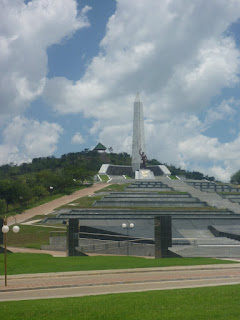
Week 7: 28 February - 6 March
This week in “Racism and Resistance in Southern Africa and the United States” we visited Heroes’ Acre outside of Windhoek. Heroes’ Acre was opened on August 26, 2002 by President Sam Nujoma to commemorate the lives lost during the liberation struggle. It was constructed as a way to remember the past while celebrating the future. It was also created to instill a sense of nationalism and patriotism for the newly independent Namibia. The City of Windhoek donated the 732 acres needed for the site and contracted the construction of the monument to a North Korean company for N$60 million.
Heroes’ Acre is situated between two hills and overlooks the entire city. At the entrance of the monument, there is a statue of two young adults facing in the direction of the graves to pay tribute to the fallen heroes. Next there are streetlights lining either side of the path, which are bowing as a sign of respect. At the foot of the steps is the eternal flame which is a sign of life as many people experienced rejuvenation after Namibia’s independence. At the corners of the monument are guards protecting the legacy of the heroes and the grave sites. At the top is the white obelisk, in the shape of a sword, which symbolizes bravery and dedication to the liberation struggle. The soldier in bronze is dedicated to the unknown soldiers and underneath lies sand from mass graves in Zimbabwe and Zambia so those who lost their lives abroad can rest in peace in independent Namibia. Finally the curved shape of the monument represents the epic journey from a past of oppression and colonialism to the creation of a free and independent country.
Heroes’ Acre also had a burial site with 174 tombs which are not all occupied. Distinguished individuals buried include Mose Penaani Tjitendero, the first speaker of the National Assembly, and Peter Tsheehama, the commander of the People’s Liberation Army of Namibia and the Chief of Namibian Intelligence. Other fallen heroes, who are honored but not buried on the premises, include Hosea Kutako who cofounded SWAPO and was the leader of Hereroland. As the generations pass on, heroes will continue to be honored at this national monument.
One of the first issues that struck us was the fact that visitors have to pay an entrance fee to be admitted into the monument. In a country with extremely high levels of poverty and unemployment, this makes it difficult for most Namibians to visit a monument that is supposed to be dedicated to their own history. This also reminded us of Freedom Park in Pretoria, South Africa, which was also constructed to commemorate the lives lost during South African history from slavery to the struggle against apartheid. At Freedom Park, there is also an entrance fee which makes it inaccessible to a majority of the population.
Another controversy surrounding the construction of Heroes’ Acre was the decision to contract a foreign company for construction. Though it was supposed to cost N$60 million, it ultimately cost the country double that price. While some have criticized this as corruption, we believe this could have served as an opportunit
It was very interesting to go to a monument honoring the liberation struggle and commemorating post-apartheid Namibia after seeing so many vestiges of the colonial past, especially the juxtaposition of Heroes’ Acre to Alte Feste. Alte Feste was built in 1890 and serves today as the National Museum of Namibia. While it did highlight the success of the liberation struggle and the election of SWAPO as the majority party in 1990, it also romanticized German colonial life through exhibits and completely ignored the site of one of the Herero concentration camps during the genocide.
Ultimately Heroes’ Acre was built as a national monument meant to unify the nation after years of apartheid and colo

No comments:
Post a Comment